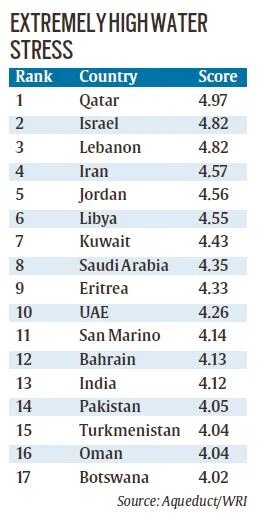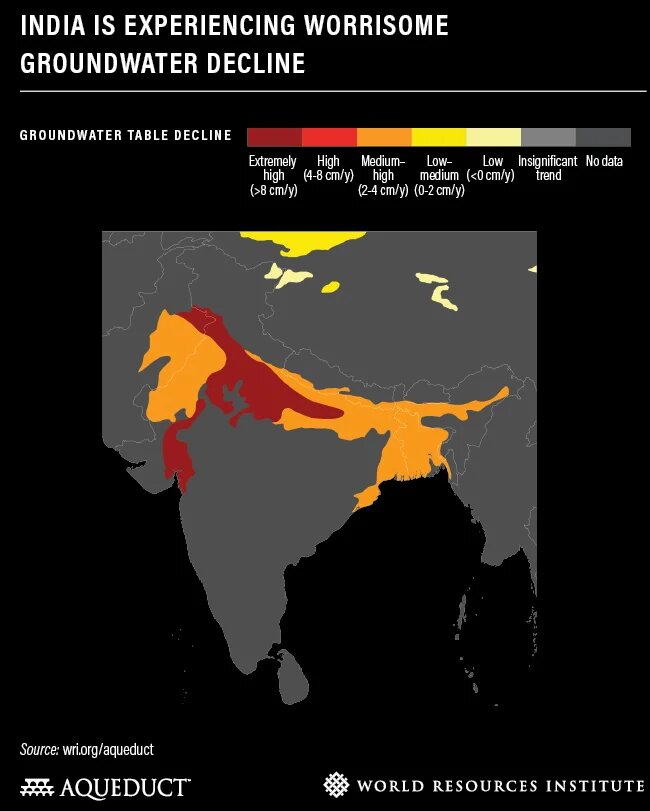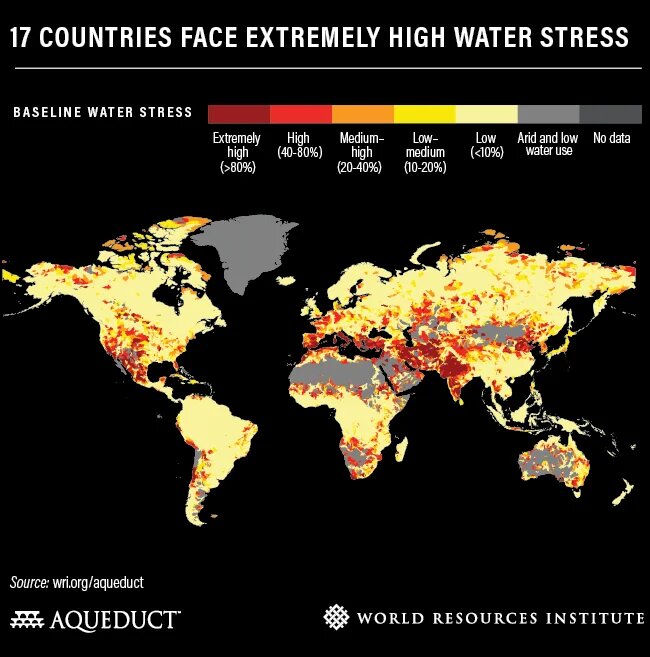Biodiversity & Environment
Water Stress in India
- 07 Aug 2019
- 5 min read
According to the data released by the World Resources Institute (global research non-profit organization), India is ranked 13th among the 17 most water stressed countries of the world.
- The Aqueduct tool used by the WRI ranks countries on the basis of water risk scores which are determined using 13 indicators of water risk.
Aqueduct Water Risk Atlas
- Aqueduct's global water risk mapping tool helps companies, investors, governments, and other users understand where and how water risks and opportunities are emerging worldwide.
- Aqueduct tools allow users to better see and understand water risks and make smart decisions to manage them.
Global Findings
- Baseline Water Stress (BWS): One-quarter of the world’s population faces extremely high levels of baseline water stress.

- It implies that irrigated agriculture, industries, and municipalities withdraw more than 80% of their available supply on average every year.
- The BWS layer, developed as part of WRI's Aqueduct Water Risk Atlas, measures the ratio of total water withdrawals (municipal, industrial, and agricultural) relative to the annual available renewable surface water supplies.
- Rising Water Demand: Globally, water withdrawals have more than doubled since the 1960s due to the growing demand for water supply.
- Water Stressed Countries: Twelve out of the 17 most water-stressed countries are in the Middle East and North Africa(MENA) region and the reason for this can be attributed to the geographical conditions (hot and dry) of the region that have created a water supply and demand imbalance.
- The World Bank found that this region has the greatest expected economic losses from climate-related water scarcity.
- Water Stressed Communities: Even in countries with overall low water stress like in South Africa (SA) and the United States (US), communities in Western Cape (SA) and New Mexico (US) may still be experiencing extremely stressed conditions.
- Top 17 water stressed countries are, Qatar, Israel, Lebanon, Iran, Jordan, Libya, Kuwait, Saudi Arabia, Eritrea, UAE, San Marino, Bahrain, India, Pakistan, Turkmenistan, Oman and Botswana.
India Specific Findings
- India is ranked 13 on Aqueduct's list of 17 extremely highly water-stressed countries.
- Northern India which was included in calculations of water stress for the first time, faces severe groundwater depletion.
- Chandigarh tops this list, followed by Haryana, Rajasthan, Uttar Pradesh, Punjab, Gujarat, Uttarakhand, Madhya Pradesh and Jammu and Kashmir.
- India’s water crisis challenges extend beyond Chennai, which was recently reported to have run out of water.
Consequences
- Food Insecurity: Water is key to food security as agriculture requires large quantities of water for irrigation.
- Water Conflict and Migration: The loss of livelihood due to increasing water scarcity and variability could force those affected to migrate.
- Financial Instability: According to the World Bank, Increasing water scarcity could erode some nations’ gross domestic product, triggering economic problems and a host of other issues.
Recommendations
- Efficient Irrigation: In order to curb the problem of baseline water stress,(i.e excessive water withdrawal) countries must switch to more efficient irrigation technologies.
- Water Conservation: Steps must be taken to promote the conservation and restoration of water bodies like lakes, floodplains, ponds and more emphasis must be laid on groundwater recharging to avoid groundwater crisis.
- Water-related Data: India can manage its water risk with the help of reliable and robust data pertaining to rainfall, surface, and groundwater to develop strategies that strengthen resilience.







